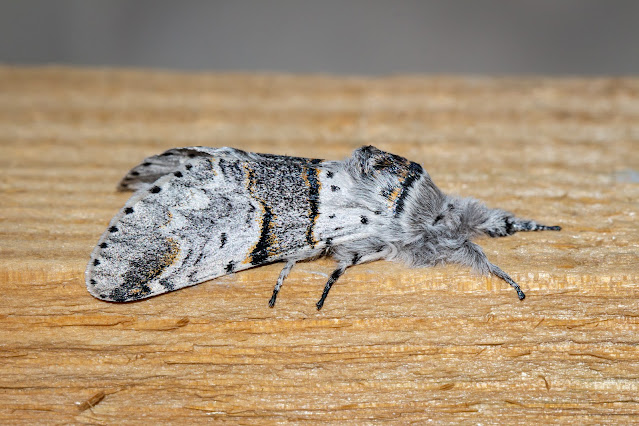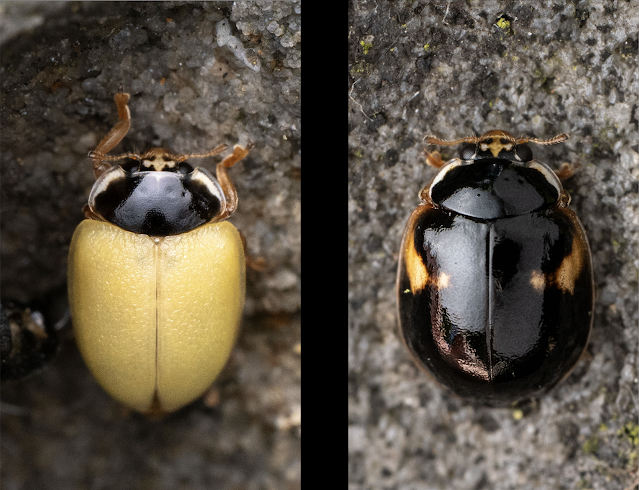TrogTrogBlog
My Blog List
Monday, 30 June 2025
May moths
Thursday, 26 June 2025
Shy birds on OtterCam
OtterCam is in a quiet phase at the moment. Single otters wander past every now and then, both the dog and the resident female as far as I can tell, but they don't do anything interesting. I hope new cubs will be born in the first half of next month but, if so, we won't see them on camera for another three months or so.
The cameras are still in position, however, clocking up dozens of recordings a day, mostly of birds. Young water rails, moorhens and mallards predominate, along with robins and wood pigeons. There were also two notable recordings last week.
The water rail has a reputation of being a shy bird but it certainly isn't camera-shy. It is usually heard rather than seen and makes a weird un-bird-like sound, often described as like a piglet squealing. This one put on a show in front of two of the cameras.
Next another bird that is usually seen but not heard. I previously posted videos of a common snipe and a badger, both with a Cetti's warbler singing in the background. The video below shows the first time a Cetti's warbler has appeared on camera. Cetti's warbler was previously a rare bird, having first bred in Kent in the 1970s and described in my (2016) field guide as a "scarce and local resident, mainly in southern England". Since then it has been spreading north and for the past year or so there have been several in the reserve - I now hear one singing nearly every time I go in. Unfortunately this one didn't sing to the cameras and the bird in the background is a reed warbler.
You can hear the Cetti's warbler's song here.
Thursday, 19 June 2025
Summer ladybirds
There is always more to learn. I manage to identify most adult ladybirds and have come to recognise urban cemeteries as good places to find them in the winter. In summer there are larvae and pupae to find and it turns out that, for some at least, cemeteries are a good place to look as well.
Ladybird larvae moult as they grow and go through four instars (stages). They get easier to identify as they get bigger. Some of those I have seen recently are 18-spot Ladybird,
Cream-streaked Ladybird,
Eyed Ladybird (also in the header photo),
Cream-spot Ladybird,
and Harlequin Ladybird, seen here alongside a pupa,
this one is a Cream-spot Ladybird
When the new ladybirds emerge from the pupal cases they are very often very pale without the characteristic colours and markings which take hours or sometimes longer to develop. This is a just-emerged Harlequin Ladybird which hasn't yet hardened and folded its wings.
After a day or so the new ladybirds are also very bright and shiny. This is a Harlequin Ladybird.
Wednesday, 11 June 2025
The next generation of woodpeckers
It's the second week of June, so time for a post on young woodpeckers. I always look out for them in early June, or more correctly listen out for them as I hear them first when they arrive in the garden, but this year the first one arrived on 31st May, probably the earliest ever here. I don't take so many bird photos these days but I always enjoy this subject. These few were distilled down from several hundred photos taken through the kitchen window in the past few days.
Thursday, 5 June 2025
The honeymoon is over on OtterCam
Then after 19 days they were still together, this time in daylight, rolling around on all the willow catkins and looking very relaxed.
The last time I saw them together was 22 days after courtship began but this time one was chasing the other and I expect they have now gone their separate ways. It isn't easy to tell who is chasing who. The first one seems to have a broader head and so may be the male.
The cameras now show only single otters although on occasion they are only a few minutes apart.
Saturday, 31 May 2025
Ladybirds spring into action
Time is pretty much up for the current generation of ladybirds. They overwintered as adults and emerged from "hibernation" (diapause) in early spring. Time for eating and mating and egg laying and then their course is run. Eggs are already laid and larvae have emerged to begin the cycle all over again. In winter the easiest place to find ladybirds is on old gravestones but in spring they move to places that will best provide food for the larvae, varying depending on the species. Some of my favourites are pine tree specialists and these are a few of those I found on young Scots pines at Havannah Nature Reserve, just a couple of miles from here.
These are Eyed Ladybirds.
And Striped Ladybirds.
The third of these three Striped Ladybirds temporarily got a bit confused. He soon realised his mistake, apologised, and went off to try his luck elsewhere.
Two 10-spot Ladybirds, both f decempunctata.
Two more 10-spot Ladybirds, the male f. decempuntata and the female f. bimaculata.
Two Pine Ladybirds.
And two Harlequin Ladybirds, both variations on f. succinea.
Ladybird eggs all look pretty much the same and can't be identified to species. These are on a pine needles which narrows it down a bit.
Most of the larvae are distinctive and can be identified to species. This is a Striped Ladybird.
This is a 7-spot Ladybird.
And this is a Pine Ladybird.
This is what the larvae like to eat, a Large Pine Aphid (Cinara pinea).
The colours and markings of our brightly coloured "conspicuous" ladybirds are often said to be aposematic (denoting colours or markings that serve to warn or repel predators) but it struck me that on pine buds they can work as camouflage as well. Look at these Striped Ladybirds,
a 10-spot Ladybird,
and an 18-spot Ladybird,































































